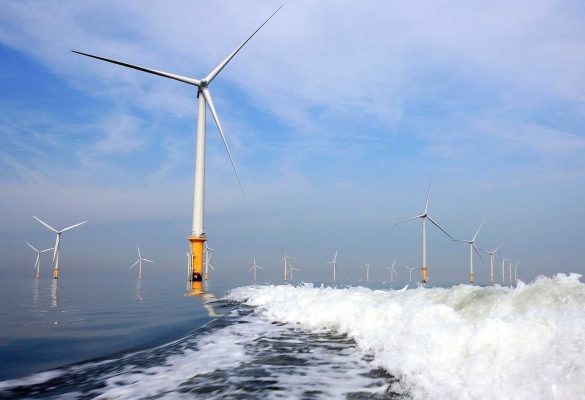With over 3,000 km of coastline and a total sea area of about 1 million km2, Vietnam has significant offshore wind power potential. Numerous studies have reported average wind speeds at a height of 100 meters in Vietnam’s offshore areas ranging from 9 to 10 m/s. These studies also indicate that Vietnam has a technical wind power potential of 599 GW, including 261 GW of fixed foundation offshore wind and 338 GW of floating foundation offshore wind.

Wind power, in general, and offshore wind power, in particular, are expected to be important renewable energy sources contributing to many countries worldwide. So, what is the trend in offshore wind power technology? Let’s explore.
Trends in Site Selection
The selection of sites for offshore wind projects is related to key factors such as seabed depth, distance from the shore, understanding of the project location, project scale, and supporting infrastructure. Globally, new offshore wind projects tend to develop with larger capacity, farther from the shore, and in deeper waters.
Studies also suggest that the choice of locations farther from the shore in deeper sea areas may be due to the increasing technological advancements in foundation structures, thorough understanding of project locations, assessment of potential risks through marine surveys, geotechnical investigations, maritime currents, and the scarcity of nearshore locations.
Moreover, continuous advancements in the electricity grid infrastructure (such as high-voltage submarine cable technology, high-voltage direct current (HVDC) systems) enable the transmission of more electricity over longer distances with lower transmission losses.
In Vietnam, most offshore wind farms in operation for commercial use are constructed on nearshore sandbanks in the southwestern coastal region (within the limit beyond the lowest average sea level for many years and within a 3-nautical-mile distance, approximately 5.6 km). This area has shallow water depths (2 to 10m), weak geological conditions, and minimal impact on maritime activities.
Following the surge in investment to benefit from preferential electricity selling prices, the next phase for investors is to build offshore wind projects farther from the shore, in deeper waters, where wind speeds are more favorable for constructing wind farms ranging from hundreds to thousands of megawatts.

Offshore wind projects tend to choose locations farther and deeper from the shore.
Technology Trends
In terms of technology, offshore wind turbines are prioritized, primarily because they are not constrained by transportation issues as much as onshore turbines. This allows offshore wind turbines to have larger dimensions. Additionally, maximizing the highest power range on a project with a specific total capacity reduces the number of turbines installed, thereby reducing both capital expenditure (CAPEX) and operating expenditure (OPEX) per megawatt.
In practice, the calculated electricity output increases proportionally with the diameter of the wind turbine blades (increasing swept area). Therefore, to increase the power of offshore wind turbines, the diameter of the blades needs to be increased while ensuring factors related to load and impact force. Hence, original equipment manufacturers (OEMs) aim to increase blade diameters to over 200 meters for their new offshore wind turbines. Hub height also increases corresponding to blade diameter to maintain a distance of approximately 25 to 30 meters between the blade tip and the water surface, with hub height expected to be around 120 to 140 meters.
Forecasts from the Global Wind Energy Council (GWEC) also show a strong trend in increasing offshore wind turbine power up to 2025. The common turbine size is expected to range from 15 to 17 MW by 2025.
In Vietnam, offshore wind projects are still in the project development stage. However, considering the deployment of onshore and nearshore wind projects, the development trend for offshore wind turbines in Vietnam is expected to keep pace with global trends or, at least, be similar to that of China. OEMs will consider the wind conditions in Vietnam and make appropriate adjustments for the most effective technical, economic, and environmentally friendly solutions.
Ban Truyền thông!


 VN
VN CN
CN KR
KR JP
JP